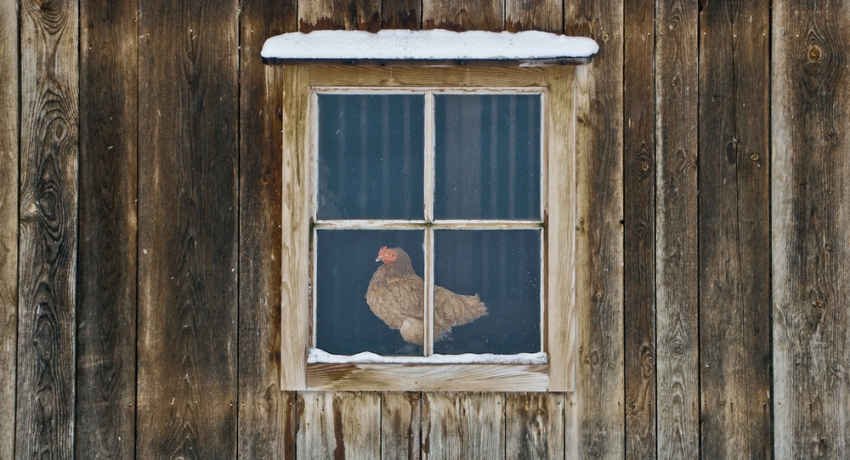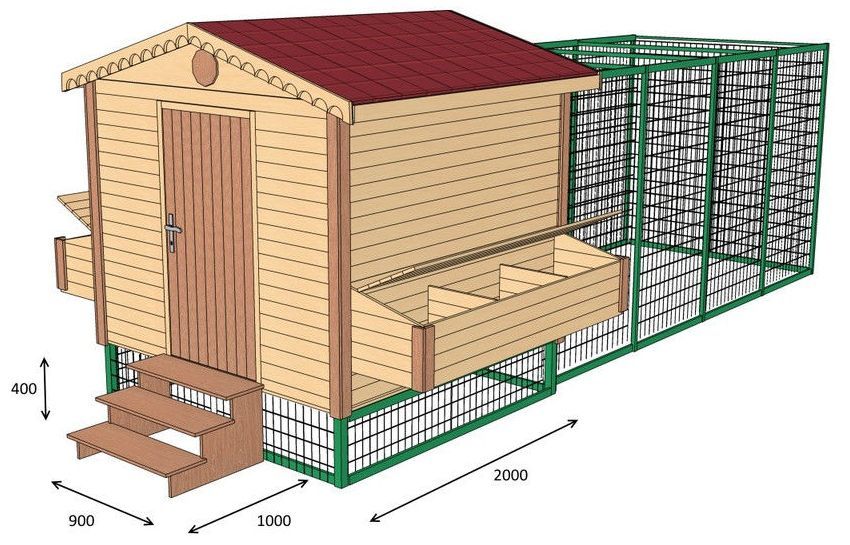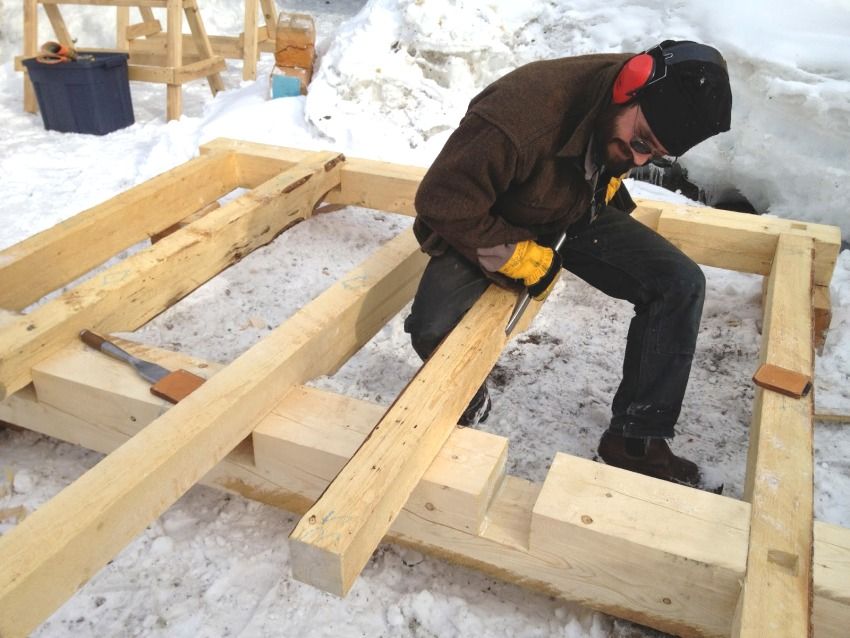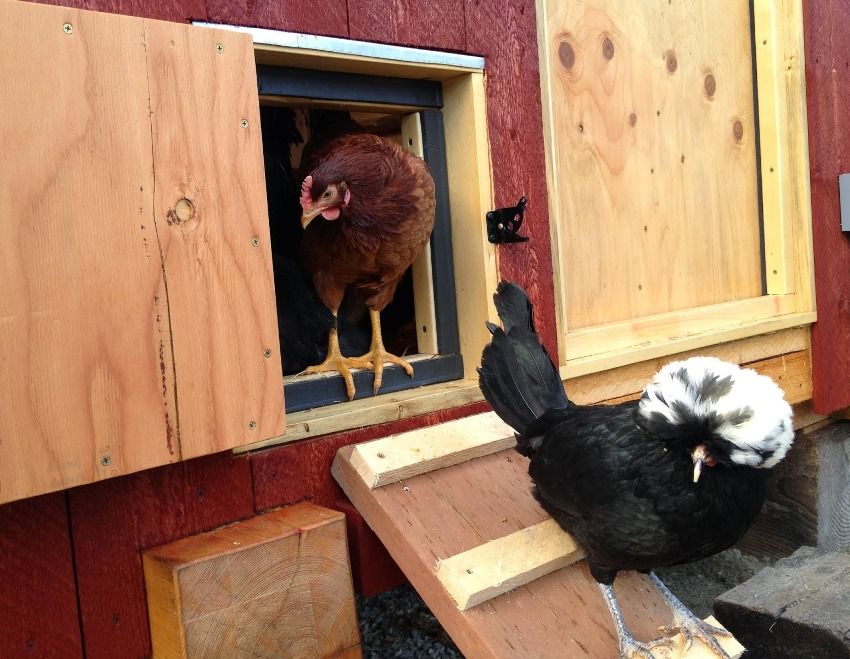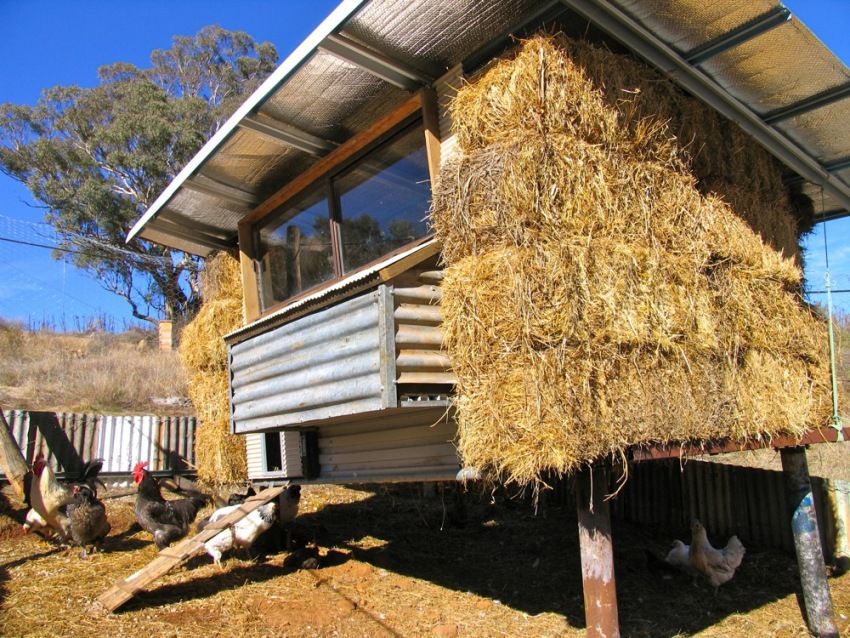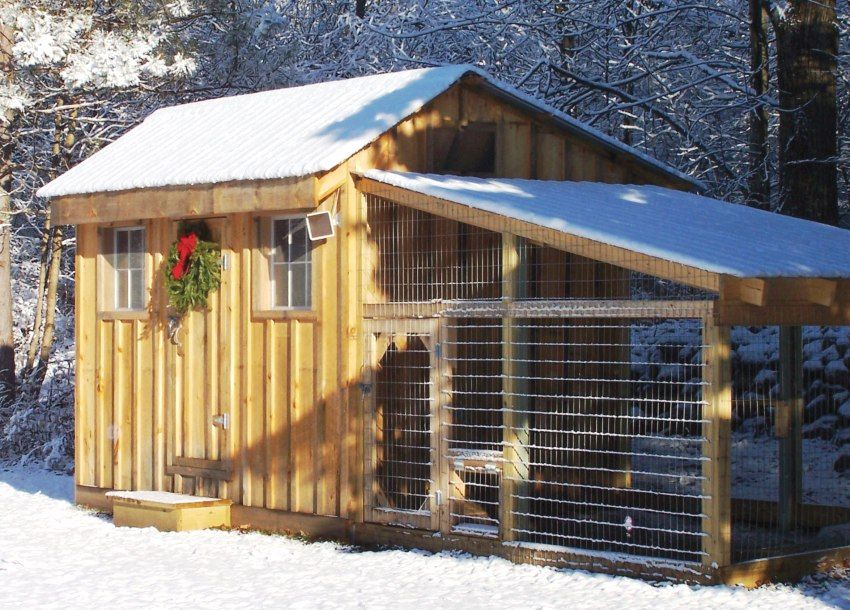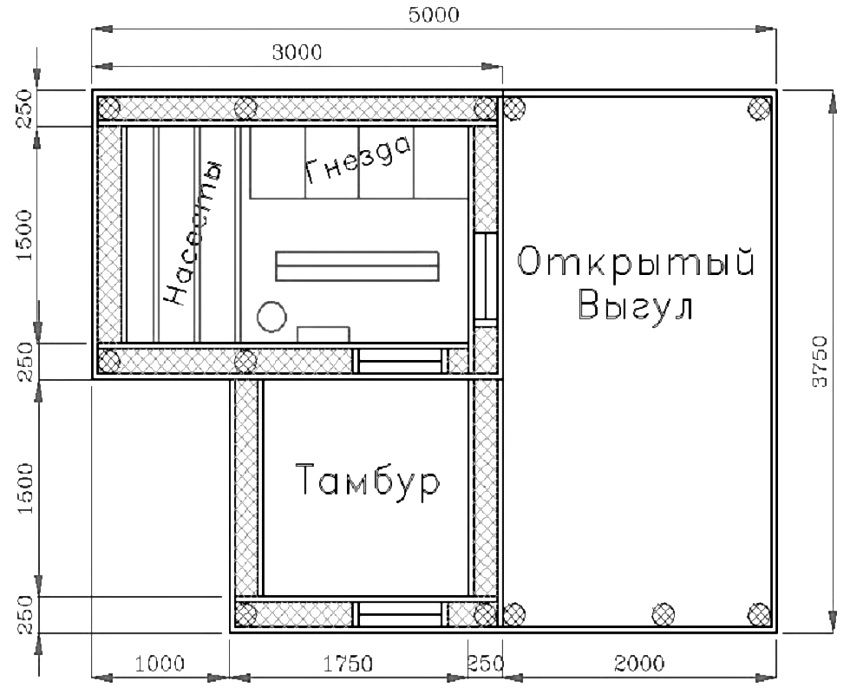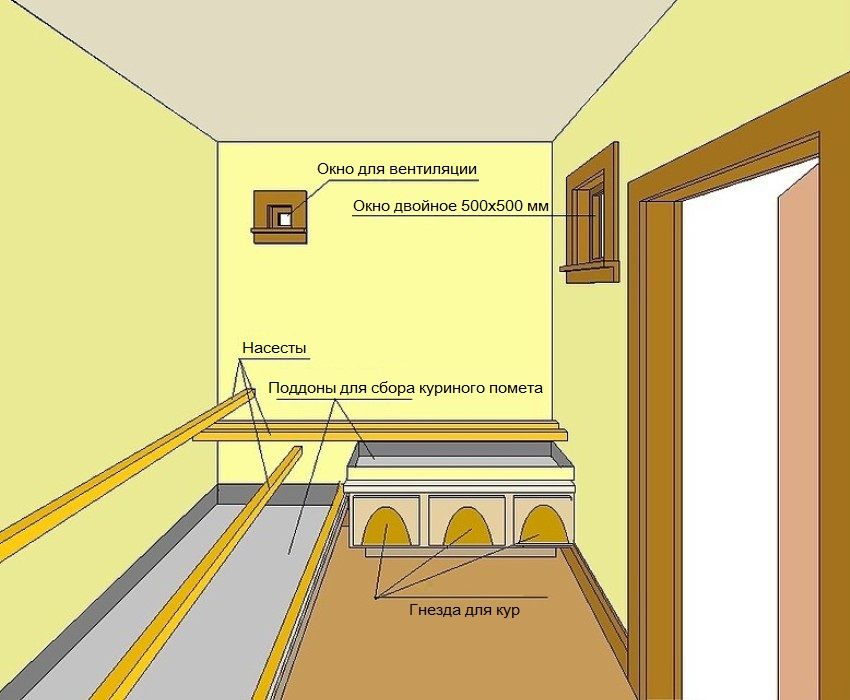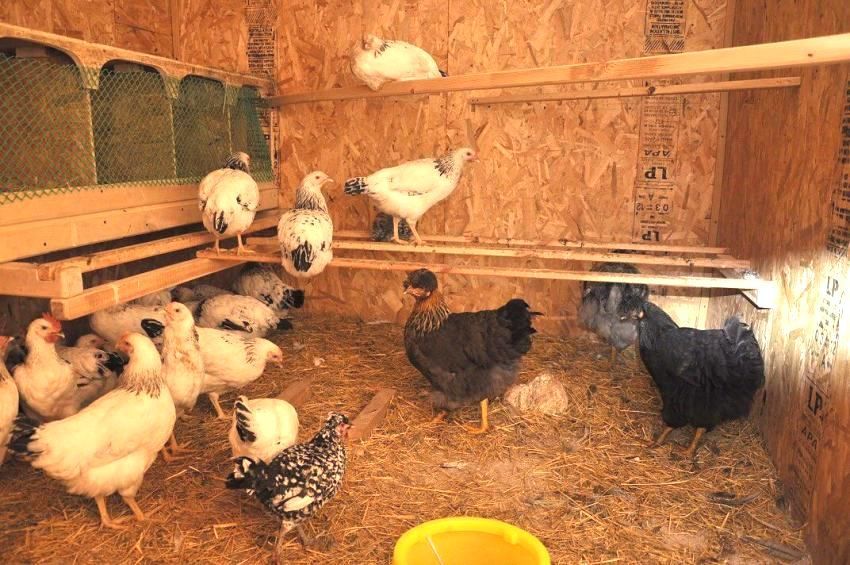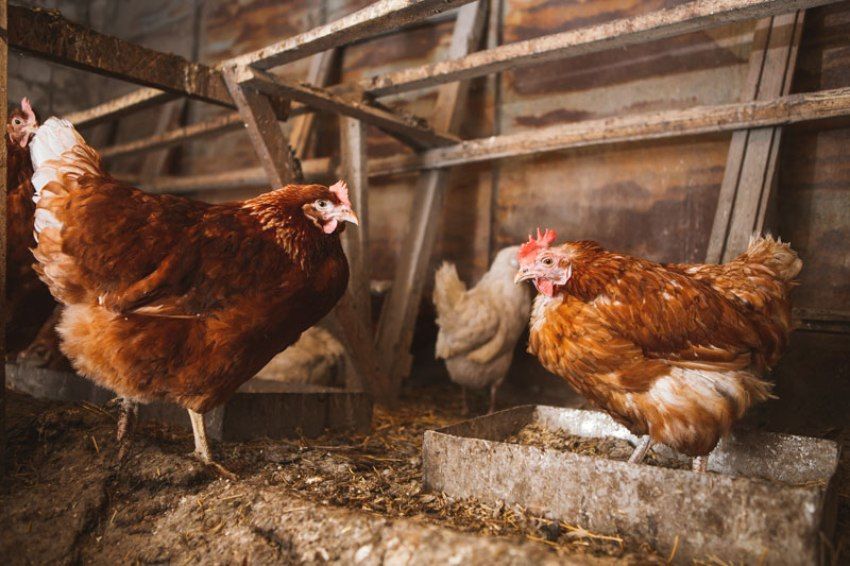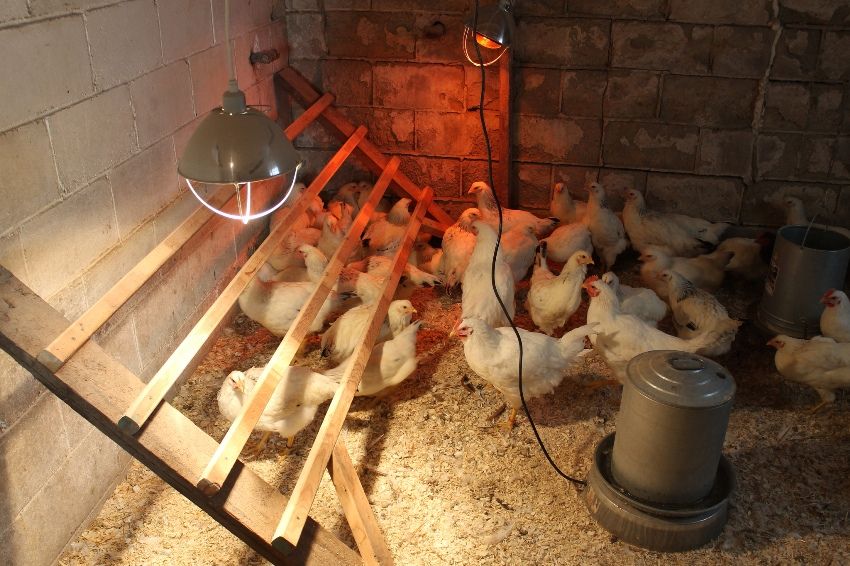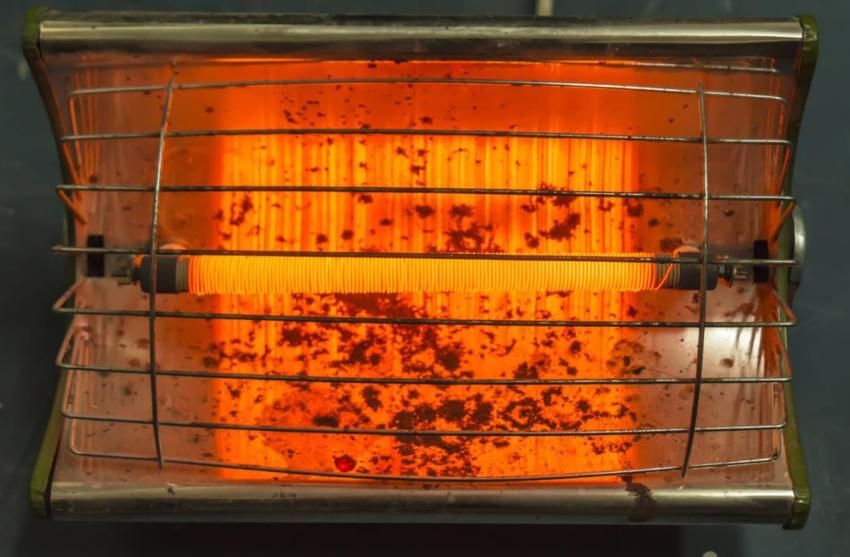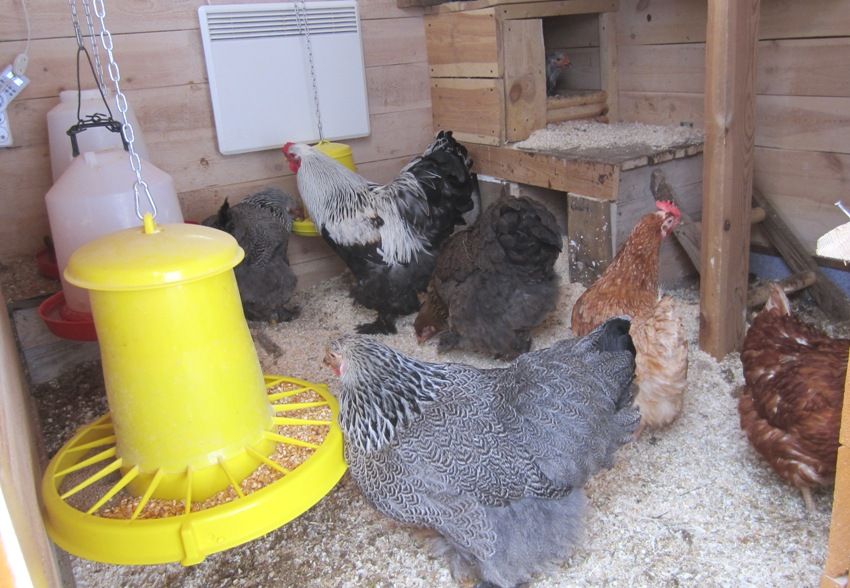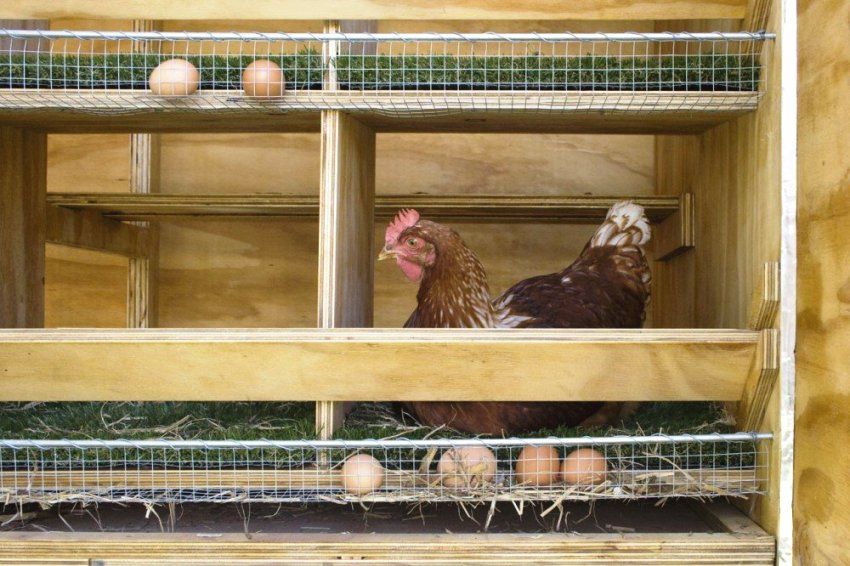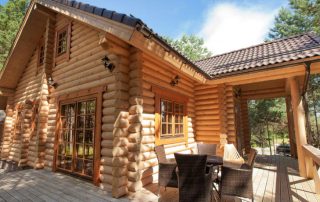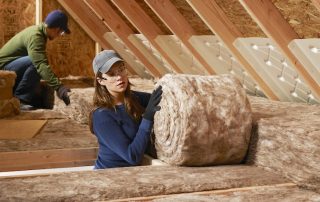Every owner wants his chickens to grow quickly, well and lay more eggs. However, it is often forgotten that this is possible only if the bird lives in good conditions, in which it will feel comfortable. This is why it is a mistake to place chickens in sheds and outbuildings. It is worth spending a little time and effort to create a suitable "house" and the result will not be long in coming. The article will discuss how to make a winter chicken coop with your own hands for 20 chickens.
Content [Hide]
- 1 Do-it-yourself winter chicken coop for 20 chickens: what type of building to prefer
- 2 How to build a warm chicken coop: choosing the type of foundation
- 3 How to make a chicken coop for wintering chickens: the choice of materials
- 4 How to insulate a chicken coop for the winter with your own hands: the choice of insulation
- 5 Choosing the best place for the location of the chicken coop on the site
- 6 DIY construction of a chicken coop for 20 chickens: drawings
- 7 Calculating the size of a chicken coop for 20 chickens
- 8 Building walls for a poultry house: technologies and materials
- 9 Ventilation in the hen house in winter: diagram and description
- 10 Features of the interior decoration of the poultry house
- 11 Lighting the chicken coop in winter
- 12 Heating the chicken coop in winter: features and options
- 13 How to heat a chicken coop in winter without electricity
- 14 Winter chicken coop: buy or build?
Do-it-yourself winter chicken coop for 20 chickens: what type of building to prefer
Some owners keep birds in the chicken coop all year round, while others leave them in this courtyard building only for the summer period. First of all, decide what you will do, because understanding the temperature regime and the weather in general outside the chicken coop will be important during construction.
Build a warm chicken coop with your own hands
Before proceeding with the construction, it is worth choosing the type of hen house that is optimal for the set goals, as well as deciding on the necessary materials and making a detailed plan for the future hen house.
If you started building a winter chicken coop with your own hands, first of all take care of the insulation of the room - and then you can be sure that even in cold weather there will be fresh homemade eggs on your table.
Helpful advice! At the construction planning stage, include the vestibule in the plan: its construction does not require much effort, but at the same time it can significantly reduce heat loss.
There are several types of buildings and when choosing a suitable option, it is worth proceeding both from your capabilities and the territory on the site that you are ready to allocate for the poultry house, and the comfort of the inhabitants of the hen house. One of the best options is a chicken coop with a courtyard - it consists of two parts and is the most convenient for the birds, although it takes up a little more space than conventional poultry houses.
Two parts of such a chicken coop:
- Indoor room.
- The courtyard is fenced with bars.
In this version of the design, the chicken can, if necessary, sit inside or walk in the fresh air.
How to build a warm chicken coop: choosing the type of foundation
The foundation is the basis of any structure, which is why it is so important to immediately determine its type. First of all, you should carefully weigh all the pros and cons of each option.
Advantages and disadvantages of different types of foundations for chicken coops:
| Foundation type | Benefits | disadvantages |
| Tape | High reliability rate | The high cost, justified when building a house, but not when building a chicken coop |
| Columnar | Cheapness and simplicity of design | Less reliability compared to tape version |
| Pile | High reliability and simplicity of construction: using modern screw piles, two people can easily cope with the construction of the foundation | Relative high cost: a pile foundation is cheaper than a strip foundation, but more expensive than a column foundation |
How to make a columnar foundation: step by step instructions
The most common choice is a columnar foundation: it does not require much time and effort, while guaranteeing the reliability and stability of the building. Let's figure out how to make such a foundation on our own:
- start with markup. To do this, take a rope and several thin long pegs or metal rods;
- then it is necessary to put pegs in the corners of the future structure and pull the rope. Make sure that the markings are even. The rope should be stretched, but at the same time trail along the top layer of the earth;
- dig a 15-20 cm depression inside the marked area - it is necessary to remove the top layer of earth;
- dig holes for the posts. Their depth should be approximately 60-70 cm, and the width should correspond to the parameters of two bricks, that is, approximately 50-55 cm. The distance between the pits should be 1 m. The curbstones should be installed around the entire perimeter of the future chicken coop;
- after completing digging holes, pull another rope over the rods. It should be 20-25 cm above the ground. In order for the design to turn out smooth and neat, use a level;
- it is necessary to pour a small layer of sand at the bottom of each pit. The thickness of this layer should be 5-7 cm;
- then fill in the same layer of gravel - both layers serve as a cushion for the future foundation;
- put two bricks on the bottom of the hole. Next, put the cement solution there in a ratio of 1: 3;
- lay two more bricks across. Repeat the steps until the height of the pedestal reaches the level of the upper rope;
- if the height of the post turned out to be insufficient, level it with cement;
- to protect the foundation from the destructive effects of moisture, its basement should be covered with gravel.
How to make a chicken coop for wintering chickens: the choice of materials
In order for the structure to be comfortable and durable, you should choose the right materials in the best way. To build a house you can use:
- foam blocks;
- shell rock;
- wood;
- brick;
- cinder blocks.
Consider the features of the most popular materials:
- Foam blocks: not the most budgetary, but the most comfortable option for birds.
- Brick: The most durable material, the construction of which remains intact and functional for decades.
- Wood: the most popular solution, which is economical, practical and durable if the logs are properly treated. In addition, such a house looks stylish and harmoniously fits into the landscape of any site.
The material for the foundation is chosen according to the following principles:
- For pedestals under a columnar foundation, any available material will do. Popular options are regular stone or old or new brick.
- For the manufacture of strip foundations, reinforced concrete is used. The frame is assembled from metal reinforcement; components are also needed for the manufacture of concrete mortar.
- The pile foundation is made using special reinforced concrete or metal piles. The most modern option is metal screw piles, which can be easily screwed into the ground without the help of professionals.
How to insulate a chicken coop for the winter with your own hands: the choice of insulation
The optimal material for wall insulation is foam.
Helpful advice! When laying the insulation, be sure to ensure that the foam is covered, otherwise the chickens may peck at the material. Geese perceive styrofoam as food, so if these birds are kept on your site, you need to be especially careful about the insulation being closed.
If your coop is made of planks, remember to put rock wool between the two layers.
How to heat a chicken coop in winter, if you plan to keep birds in it all year round, will be discussed below. As an additional insulation, choose expanded clay, roll materials or coal slag.
An important part of the chicken coop is the roof - the temperature inside the building will depend on its reliability. It is important that there are no cracks in the roof and that it does not leak. First of all, decide on the material suitable for roofing work. This capacity can be:
- professional flooring;
- metal tile;
- slate.
The type of roofing material in the case of a chicken coop does not really matter. The main purpose of the roof is to keep moisture out of the house, so the main task is to properly deck the roof to avoid leaks.
Choosing the best place for the location of the chicken coop on the site
To choose the optimal place for a chicken coop, convenient for building and comfortable for chickens, follow simple principles:
- in the lowlands, as a rule, it is very damp: in the spring the earth dries out more slowly after the melted snow, and after rains puddles appear there. Thus, it is better to locate the poultry house on a hill - in addition, it is more convenient to walk chickens there;
- birds love peace, so it is worth placing the chicken coop away from outdoor activities and sources of noise;
- the well-being of birds is directly proportional to the amount of sunlight they receive, therefore, if possible, you should make sure that the windows face south;
- overheating is harmful to birds, so in extreme heat it is worth shading the windows;
- the chicken coop should be located near a person's home so that you can regularly watch the birds;
- Locate the house on dry, sandy soil. In the case of clayey, swampy or simply wet soil, it should be pre-drained;
Helpful advice! Use drainage channels or pits and then fill them with sand. In the future, you can use drainage channels, ponds or pits for bathing chickens. An ideal place for poultry farming - with a south-east bias.
- make sure that the area chosen by you for building a poultry house is reliably protected from cold winds - for this, planting in the form of shrubs and trees is optimal;
- near the poultry house for chickens there should be a platform suitable for walking, where there is an opportunity to shelter from rain, piercing wind, scorching sun and other unpleasant weather phenomena;
- for bathing chickens, it is worth equipping a small reservoir.
Choosing a location is one of the most important steps in the instructions on how to build a winter chicken coop, because an unsuitable place and uncomfortable conditions for birds affect their health. Birds become lethargic and painful, they fly less, and problems with fertilization of eggs are also possible. As a result, the chicken coop brings less and less income.
Make sure that the conditions for keeping the chickens are balanced: with high humidity, the chickens cough and become lethargic, and if in the heat under the scorching sun, the chickens do not have shelter in the form of trees, bushes or other sources of shade, there is a risk of dehydration, which threatens the death of birds.
Helpful advice! It is possible that in the future you will need to increase the number of birds. Therefore, if possible, position the chicken coop so that, if necessary, more buildings can fit next to it. Even if 20 chickens are enough for you to provide eggs for the whole family, it is possible that in the future you will decide to raise birds for profit.
DIY construction of a chicken coop for 20 chickens: drawings
Regardless of the type of chicken house chosen and the materials for its construction, in order to understand how to build a warm chicken coop with your own hands, you need to make drawings. They must be detailed and contain all dimensions. The drawing must be made in three projections.
As a result, you can easily figure out how to make a winter hen house for 20 chickens with your own hands: drawings add clarity, allow you to calculate how much materials you need, and help to avoid mistakes at the stage of building a house.
At the stage of creating a drawing, it is necessary to determine the type of roof. The best choice is a gable roof with an attic - in this case, you can store all the necessary equipment, food, etc. there without cluttering the living space and taking up space in the chicken coop. Less practical and comfortable, but have the right to life are options for a pitched roof or flat roof.
Do-it-yourself photos, drawings and sketches of the structure found on the Internet will also help for the construction of a winter chicken coop for 20 chickens.
Calculating the size of a chicken coop for 20 chickens
There should be at least 1 m² of space for two chickens in the house. In addition, keep in mind that some place will be occupied by drinkers, feeders and other auxiliary elements. Thus, in both the summer and winter versions of the hen house project for 20 chickens, there should be at least 15-20 m² of area.
Related article:
Cellar made of plastic: a good solution for compact storage of food
The advantages and disadvantages of such storages. Design selection criteria, do-it-yourself step-by-step installation. Popular brands of cellars and their features.
The height of the chicken coop should be at least 2 m in order to ensure a comfortable stay in the room not only for birds, but also for people caring for them.
Keep in mind that birds feel uncomfortable in confined spaces, which can cause disease. Therefore, sometimes it makes sense to sacrifice the number of livestock in favor of more comfortable conditions for placing birds.
For example, 20 birds housed in a 20 m² hen house will produce more eggs than 30 chickens housed in the same area.
Building walls for a poultry house: technologies and materials
If you are building a chicken coop from wood, frame technology should be preferred for building walls. You will need support beams, planks or plywood. Take care of wall insulation: it can be single-layer or double-layer.
Also, the walls are made of timber or logs.This option has a number of advantages: the finished building stores heat well, and is also distinguished by its strength and durability. As a result, the poultry house will maintain its operational characteristics for many years.
In the case of brick walls, the construction principle is quite simple. The main points are to prepare a high-quality solution that can provide the building with durability, and also do not forget to leave room for windows and doors.
Ventilation in the hen house in winter: diagram and description
Ventilation plays an important role in the construction of the chicken coop, because fresh air is very necessary for birds. It is a common misconception that the house should have warm, suffocating air. In fact, ventilation in the hen house in winter is the key to the health of the chickens, and it is worth taking care of this element before you start building the roof.
To understand how to make ventilation in a chicken coop, consider several options:
- It is best to make a pair of ventilation ducts. They should be placed at different ends of the chicken coop. Place one end of the ventilation duct at the ceiling level, and the other 0.5 m lower. Provide dampers in the ventilation pipes to easily influence the fresh air flow and temperature in the hen house in winter.
- The second option for how to make ventilation in the chicken coop with your own hands is to make special holes in the floor. In winter they are closed with plugs, in summer they use grilles that do not hold back fresh air. As a result, a comfortable microclimate is always maintained in the house.
Features of the interior decoration of the poultry house
Equally important for the comfort of chickens, along with insulated walls and a leak-proof roof, are the internal elements of the house: drinkers, feeders, perches and nests. It is possible to launch birds into new housing only after the chicken coop is equipped with everything necessary.
How to make perches, nests, drinkers and feeders
In order to build perches, you need a block:
- Choose a bar with a cross section of about 30x40 mm or slightly thicker.
- Round off the top edges of the block a little.
- Choose an impassable spot in the coop.
- Secure the perches. Please note that the distance between them should not exceed 30 cm from each other.
The optimal perch length for 20 chickens is at least 6 m for all perches. The calculation is very simple - in order for the birds not to be crowded, at least 30 cm of perch should fall on each chicken. To make housekeeping easier, place waste trays directly below the perch.
The nests are open and closed. Closed nests are the best option because birds feel safer there. However, they are more difficult to construct, and it is permissible to do with open-type nests. The size of such a nest should be at least 30x40 cm. The optimal material for making nests is wood: boards and plywood are best suited.
Ten nests are enough for 20 chickens. Line the bottom of the nests with sawdust or straw to keep the chickens comfortable. It is also worth covering the floor of the entire poultry house with sawdust or hay - this will provide the chickens with comfort, and yourself with simplicity and speed of cleaning.
Position bird feeders and drinkers some distance above the floor to prevent debris from entering bird feeders and drinkers.
Lighting the chicken coop in winter
In a summer chicken coop, it is easy to do without light. However, if you plan to use the house all year round, you will need a hen house lamp during the winter. By applying electricity and turning on the lamp from autumn to spring at night, you will extend the day for the layers, which will have a fruitful effect on their activity.
This will require certain energy costs, but they will more than pay off year-round excellent health and good egg production.
Helpful advice! Cover the lamp with a shade to avoid dust and to protect it from hay or cobwebs.
Heating the chicken coop in winter: features and options
To provide chickens with comfortable conditions at any time of the year and in all weather conditions, it is important to take care of heating. The temperature in the hen house in winter (for the chickens to rush) should not drop below 0 - in this case, the layers feel good and continue to produce eggs.
DIY electric heating of a chicken coop for 20 chickens: photo and description
In the case when electricity is supplied to the chicken coop, there are two optimal ways to heat the room:
- fan heaters;
- infrared lamps.
When choosing a fan heater, you should give preference to programmable models. They are more expensive, but in the end they will recoup the money spent with noticeable energy savings. As a result, you will pay less for the winter than with a conventional device.
Automation is adjusted according to one of two principles:
- by time;
- by temperature.
In the case of a poultry house, the temperature-adjustable option is preferred. It allows you to maintain the temperature that should be in the hen house in winter.
For example, when the temperature in the house drops to 0 ° C, the device turns on, raises the temperature to 3 ° C, and then automatically turns off.
Helpful advice! You can choose the settings of the fan heater yourself. This heating option is convenient, practical and very effective.
Choosing an infrared lamp for heating a chicken coop
A popular decision is to buy an infrared lamp for heating a chicken coop. The principle of operation of such a lamp for heating a chicken coop is fundamentally different from the usual devices: this type of heaters does not affect the air in the room, but objects that fall into the zone of exposure to rays.
The main thing is to correctly place infrared lamps for the chicken coop. They should be placed above the perches, and several hung above the floor. Thus, in the event that the chickens get cold, they gather in the area of the heaters. As a result, in general, the room may remain cold, but the birds will be warm.
However, it should be borne in mind that from constant switching on and off, red lamps for chicken coops quickly burn out. Therefore, try not to turn them off unnecessarily. Such a lamp can work uninterruptedly for months without requiring shutdown. At the same time, they do not require large energy costs, so there is no need to worry about the electricity bill.
Please note that a distinction is made between infrared lighting and lamps for heating chicken coops in winter. It is important not to mix them up if you decide to buy a chicken coop infrared lamp.
Please note that the surface of the lamp heats up during operation, and the design of the device is not designed for such loads. It is difficult to find ceramic sockets, and plastic ones do not hold the lamp very well.
Helpful advice! Place the chicken coop IR lamp in the wire cage. This will ensure fire safety without compromising the efficiency of the device. If the lamp accidentally falls out, there is no risk that the birds will be burned, the lamp will break, and the bedding will ignite.
There are also other possibilities, but they are noticeably inferior to the infrared lamp. For example, an oil radiator is one of the most impractical options for heating a poultry house: it is characterized by high energy consumption with a minimum amount of heat generated.
There are highly efficient homemade open coil heaters, but they are highly flammable. Considering that you regularly leave the appliance on unattended in the chicken coop, such a heater poses an unnecessary risk.
How to heat a chicken coop in winter without electricity
If your house has no electricity, or you want to save energy, you can find ways to heat your chicken coop without electricity in winter.
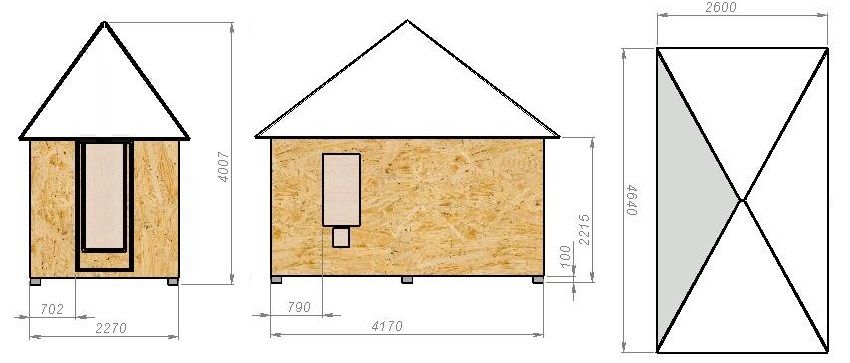
Scheme for the construction of a winter chicken coop from insulated SIP panels
One of them is a potbelly stove and a heating boiler. A convenient, but complex and cumbersome option is to carry out batteries and operate a heating boiler. The options are simpler - a stove stove, a wood-burning boiler or a small brick stove, which is easy to lay out on your own.
The main thing is to run the pipe through the hen house so that it gives the maximum amount of heat. An iron stove or pipe can be bricked for greater efficiency. A heated brick keeps heat for a long time, and in the case of high-quality insulation of the chicken coop, this heating is enough for 2 days at a comfortable temperature in the house.
Heating the chicken coop in winter with your own hands using sawdust
It is possible to achieve a comfortable positive temperature without additional heating in the hen house using the heat released by sawdust during decomposition. However, keep in mind that this option works only in the case of high-quality insulation of the building:
- sprinkle sawdust on the floor;
- the first layer should be covered in autumn, on the eve of the onset of the first cold weather;
- the layer thickness should be 10-15 cm;
- leave the layer on for 1-1.5 months.
This option of bedding surpasses hay in its operational characteristics, since thanks to the good regulation of moisture by sawdust, the chickens do not get sick. Moreover, birds love to rummage in the litter, and thanks to constant movement, even with rare walking and good nutrition, the layers will not become excessively fat.
After 30-50 days, add a new batch of sawdust: the need to add a new layer is noticeable by the appearance of old sawdust and their smell. The thickness of the new layer should be about 10 cm. After a while, repeat the procedure. As a result, by the end of the winter season, a layer of sawdust about 50 cm thick is formed in the hen house.
Thanks to the layer of files, even in cold weather, the temperature in the house does not fall below 0 ° C, and burrowing into the litter, the chickens are in a comfortable mode of about 20 ° C. Birds dig holes and settle in them, sawdust prefers, and as a result of the reaction, a large amount of heat is released.
Helpful advice! In spring, all sawdust mixture should be taken out to compost pit... After a short time, you will receive excellent fertilization.
In advance, in the fall, it is worth filling the board in front of the door - then the litter, reaching its final thickness, will not get enough sleep through the door. This will somewhat complicate walking through the door, but it will eliminate the resulting draft.
Winter chicken coop: buy or build?
There are many advantages in building a chicken coop on your own: it is much cheaper than purchasing a ready-made one (from 25 thousand rubles and more), and most importantly, a self-built poultry house meets all the needs and is individually designed for your site. You can provide him with an ideal place and even provide for the possibility of expanding the farm for the future.
However, sometimes it is better to buy a winter chicken coop for 20 chickens: not everyone has the energy and time to design, select materials and build a chicken house. In addition, this requires some experience. In this case, it is better to buy a ready-made poultry house, equipped with everything you need, than to keep the birds in unsuitable conditions for them or build a chicken coop without having the necessary funds and skills.
